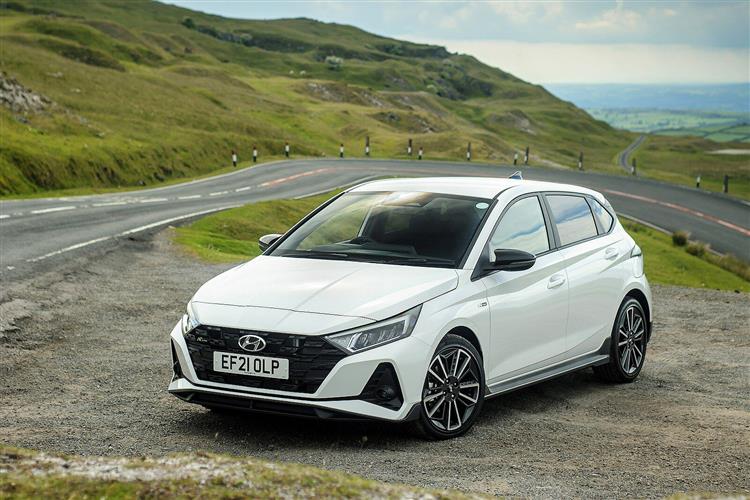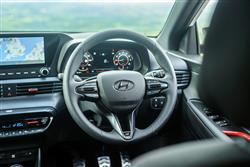How will you view?
This is a sample, showing 30 seconds of each section.
TWENTY TIMES SENSIBLE (some text hidden) SECTIONED_new_hyundaii20_2021
By Jonathan Crouch
Introductionword count: 96
Here's a rather different kind of Hyundai i20. This third generation version was different in terms of style and sophistication, with mild hybrid engine tech and the kind of media and safety features you'd usually expect to find on a much larger car. At the same time though, quite a few recognisably sensible character traits from previous models still remained. It's now reasonable these days to expect much more of a supermini and in many respects, this car can now really deliver on that brief. Here, we look at the 2020-2023-era pre-facelift versions of this car.
Modelsword count: 3
5dr supermini [1.0/1.6T-GDi]
Historyword count: 314
Hyundai might have established itself as a sensible budget brand but these days, the company has much higher aspirations than that. Even its most sensible models now have more than a modicum of style, technology and just a bit of a 'want one' factor. For proof of that, check out this one, the brand's third generation i20 supermini. There's no getting around it; in its previous two 'PB' and 'GB'-series incarnations, respectively launched in 2009 and 2015, the i20 was rather dull. There's certainly a market for that, as evidenced by the fact that over 100,000 examples of the second generation version were sold in Europe - and even more than that in India, the car's biggest market. Customers here though, tend to require a little more character from their supermini selection. Something it was going to take more than an expensive World Rally Championship programme for the old MK2 model to deliver. This replacement 'BC3'-series design though, had higher aspirations. There was a much sharper look and buyers got a more spacious cabin, plus all the volume variants had 48-volt mild hybrid engine tech. In addition, mindful of the fact that almost half of all sales of its larger i30 family hatch were of seriously sporty variants, Hyundai went all out to make sure those bases were covered here. 'N Line' models offered a warm hatch vibe and at the top of the range, there was a full-fat i20 N shopping rocket version that went gunning for the Fiesta ST. On top of that, there was a clever new Intelligent Manual Transmission system, stronger standards of safety and big car-style media provision. A sporty 'N Line' trim arrived in 2021, as did the aforementioned potent 1.6-litre turbo i20 N hot hatch. The MK3 i20 sold in this form until mid-2023, when it was lightly facelifted. It's the pre-facelift models we look at here.
What You Getword count: 455
Hyundai's clearly on a mission to banish dull design from its product portfolio. By 2020, we'd already seen that from the Tucson and the IONIQ 5 and the point was emphasised again here by a third generation i20 that looked nothing like either of its predecessors - and was all the better for it. Particularly in profile, a perspective which delivers a wedge-shaped look, complete with slashes, contrasting colour and a rather unique swept-up design around the C and D-pillars. The front end too, is all about angles and attitude. The black grille is a great deal more overt than the previous model and on most variants gets flanked by piercing LED headlights, with upper sections framed by tick-shaped daytime running light strips. Arguably even more interesting is the rear end treatment, which features claw-shaped lamps that are LED-illuminated on most models and come connected by a central strip that aims to emphasise the bodywork's 30mm increase in width. Inside it's certainly a step forward from the cheap-feeling, rather basic cabins that have characterised this model line in the past. The sculptural fascia design helps, with its smart horizontal blades that stretch across the dash; and Hyundai was the first supermini maker to standardise a digital instrument cluster right across the range, this 10.25-inch screen offering coloured virtual dials and a customisable centre section. The Centre Console Display it's paired with will be either 8-inches or 10.25-inches in size, depending on the trim level you've selected, the larger monitor bringing something of a 'big car' feel to this ambitious little supermini, with its Bluelink telematics and Hyundai LIVE traffic services. Some of the plastics used around the cabin feel a bit scratchy and brittle, but it was all well put together by the Turkish factory and seems built to last. The seats are also reasonably comfortable and there's plenty of storage space. And the rear? Well access isn't quite as good as it was with the previous generation model because of that lower roof height, but the doors open nice and wide. And once inside, you'll find that this Hyundai has as much rear space for legs and knees as you could reasonably expect in this class. Headroom isn't quite so noteworthy, thanks to that tapering rear roof line, but the wider exterior width and the relatively low centre transmission tunnel mean it's realistic to take a trio of passengers back here if you absolutely had to, though the raised central cushion won't do much for the comfort of the middle occupant. And the boot? Well lift the hatch and you're greeted with one of the more accommodating luggage areas in the segment, 352-litres in size, which is 26-litres larger than the previous model offered.
To see the full road test text contact us on 0330 0020 227
Pictures (high res disabled)

.jpg)
|
.jpg)
|
.jpg)
| |||
.jpg)
|
.jpg)
|
.jpg)
| |||
.jpg)
|
.jpg)
|
.jpg)
| |||
.jpg)
|
.jpg)
|

|
Scoring (subset of scores)
Category: Small Runabouts
| Performance | |
| Handling | |
| Comfort | |
| Space | |
| Styling, Build, Value, Equipment, Depreciation, Handling, Insurance and Total scores are available with our full data feed. | |



